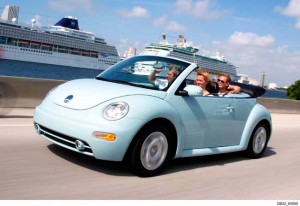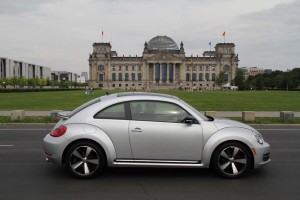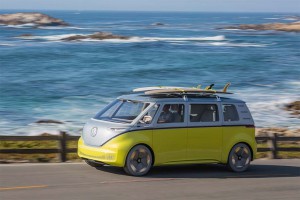Get ready to say buh-bye to the Beetle. Oh, you didn’t know they were still building it? Well, that may explain why Volkswagen is getting set to phase out the once-iconic coupe when the current, third-generation model reaches the end of its lifecycle.
Now, Volkswagen wouldn’t be Volkswagen without at least one icon in its line-up, but Frank Welsch, the brand’s R&D chief, told Britain’s Autocar that the focus will shift to the soon-to-be-reborn I.D. Buzz, an all-electric take on the classic Volkswagen Microbus that is due to market early in the coming decade.
Noting that VW tried to revive the Bug with the “New Beetle,” and then redid it one more time, Welsch said enough is enough. “You can’t do it five times and have a new, new, new Beetle,” ad infinitum. In fact, the VW board did consider a way to keep the Beetle alive, but it turned thumbs down to the idea of an all-electric version during a product meeting last November.
(Live from Geneva! Click Here for our coverage of the 2018 Geneva Motor Show.)
That’s despite support from VW brand boss Herbert Diess, who told Autocar that an all-electric Beetle “would be much better than today’s model, much closer to history, because it could be rear-wheel-drive” by moving the batteries under the load floor and mounting the motor on the rear axle.
This wouldn’t be the first time a death warrant was signed for the Beetle. The original debuted in 1938 and formally died in 2003 – by then being produced and sold in only a handful of emerging markets. The New Beetle came to life for the 1998 model-year and lasted until 2011. The current, more athletic generation followed.
In its heyday, VW was effectively the Beetle brand, especially in the U.S. where it captured nearly a 5% share of the overall market during its 1970s-era peak. The New Beetle initially clicked with American motorists, generating 83,434 sales in 1999. But demand quickly tapered off, dipping to just 6,468 by 2011. The Gen-3 model bounced back – a bit – U.S. sales peaking at 43,134 in 2013. But last year, the numbers fell to an anemic 15,166.
The U.S. has been the foundation for Beetle nostalgia. The coupe has relatively little presence in the home German market where it was long known as the “kafer.”
Rumors that the New (New) Beetle might get splatted have been circulating for several years, but this is the first time Volkswagen officials have given public confirmation, apparently because of the November board vote.
“Two or three generations is enough now,” stressed Welsch.
The German maker has laid out a strategy to substitute new models for old and, among other things, the new T-Roc Convertible will sub out for the Beetle, Golf and Eos Cabriolet models. But it’s the I.D. Buzz that is due to become the brand’s next icon reborn.
VW spent years trying to revive the old Microbus but ran into a series of problems, in part due to safety concerns predicated on the extremely flat nose of earlier concepts that simply couldn’t meet crash standards. And working off the modular MQB platform shared by most of the rest of the VW line-up today created other issues, especially with the idea of going to rear- or all-wheel-drive.
(Diesel crisis may have been just what VW needed to spur change, says U.S. boss. Click Here for the story.)
That changes with the launch of the MEB architecture that will underpin the four new models VW has so far shown that it plans to sell through the new I.D. electric sub-brand, including the I.D. Vizzion that made its debut at the Geneva Motor Show this week, as well as the I.D. Buzz van.
“With MEB, you can do a bus and be an authentic vehicle with the original shape, and steering wheel mounted like the original,” said Welsch. “You can’t do that with an engine in the front. The shape you see on the concept is realistic. We had all these Microbus concepts in the past but all were front-engined. The physicality of bringing it on MQB or PQ-something to life does not work.”
Look for the I.D. Buzz around 2021/2022, the Vizzion model to follow soon afterwards.
(Click Here for a closer look at the new VW I.D. Vizzion concept.)




